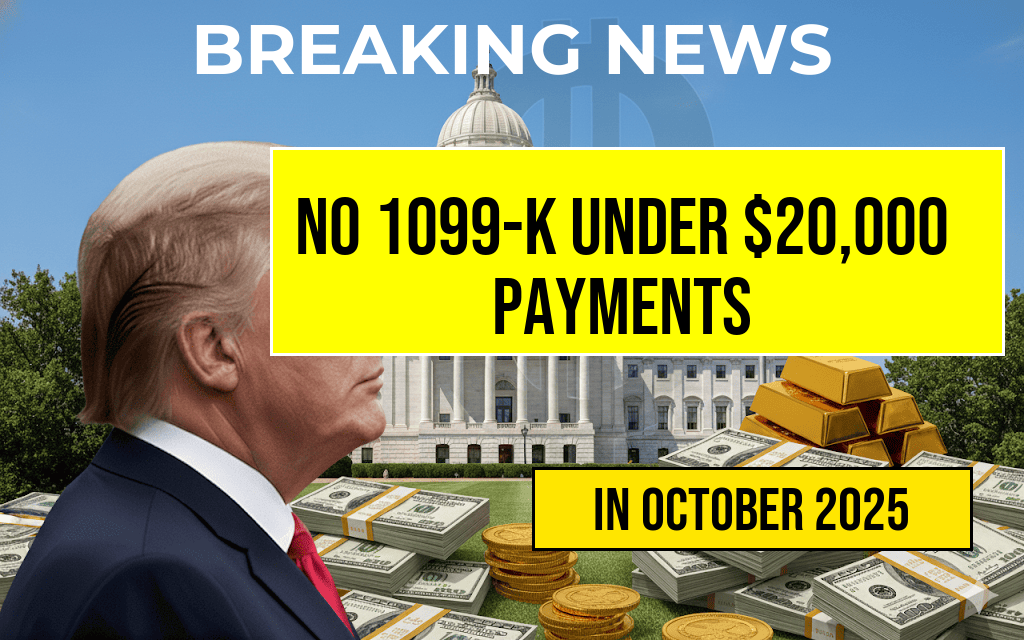As the gig economy continues to expand, many independent workers and small-scale sellers seek clarity on tax reporting obligations tied to digital payments. Recent changes in IRS reporting thresholds have clarified that 1099-K forms—which report payment transactions—are only issued when a taxpayer’s gross payments exceed $20,000 and involve more than 200 transactions annually. This threshold aims to reduce unnecessary tax reporting for small-scale side hustles, but it also raises questions about compliance and income transparency for casual sellers and entrepreneurs. Understanding these rules helps gig workers, online sellers, and freelancers plan their finances and avoid surprises during tax season, while also ensuring they meet federal reporting standards.
Understanding the 1099-K and Its Significance
The Form 1099-K is an IRS document used to report payment card transactions and third-party network payments. Originally designed to assist in tax compliance for online marketplaces and payment processors, the form provides IRS authorities with a record of gross payments made to individuals and businesses. Historically, the threshold for issuing a 1099-K was set at $20,000 in gross payments across more than 200 transactions annually, a standard established to streamline reporting for small-scale sellers and reduce administrative burdens.
The New Threshold and Its Impact
Starting with the 2022 tax year, the American Rescue Plan Act mandated that the IRS lower the reporting threshold for 1099-K forms to $600 with no minimum transaction count. This change aims to increase transparency and tax compliance among gig workers, freelance professionals, and casual online sellers. However, the Internal Revenue Service (IRS) has clarified that this new threshold applies primarily to individual taxpayers, with the previous threshold of $20,000 and 200 transactions remaining in effect for certain small-scale activities. This adjustment has caused some confusion, but the key takeaway is that 1099-K forms will only be issued for payments exceeding $20,000 unless the new $600 threshold is triggered.
Who Should Pay Attention?
- Casual online sellers: Individuals selling used goods or crafts occasionally may not reach the $20,000 threshold, especially if transactions are infrequent.
- Freelancers and gig workers: Those earning less than $20,000 annually from platforms like PayPal, Venmo, or Stripe are unlikely to receive a 1099-K, but they are still responsible for reporting all income.
- Small business owners: Entrepreneurs with higher transaction volumes are more likely to receive 1099-K forms, simplifying tax reporting.
Implications for Side Hustlers and Small Sellers
This threshold adjustment incentivizes many casual sellers to keep detailed records of their income and expenses, as they may not receive a 1099-K if their gross payments stay below $20,000. Nevertheless, the IRS requires all income to be reported, regardless of whether a form is issued. Failure to report income from side gigs can lead to penalties, audits, or other legal complications.
Strategies to Manage Tax Obligations
- Maintain meticulous records: Keep logs of all transactions, including receipts, invoices, and bank statements.
- Use accounting software: Tools like QuickBooks or Wave can help track income and expenses accurately.
- Consult tax professionals: An accountant can provide tailored advice, especially when income levels fluctuate or multiple sources are involved.
Potential Challenges and Criticisms
Some critics argue that the $20,000 threshold may still leave small-scale earners unreported, especially those who earn income from multiple platforms or side jobs. The threshold may inadvertently create a gap where small but consistent income remains under the IRS radar, leading to possible underreporting. Conversely, others believe that the threshold strikes a reasonable balance by reducing unnecessary tax reporting burdens on casual sellers while maintaining compliance for higher earners.
Looking Ahead: Evolving Tax Policies
The IRS continues to adapt its reporting requirements to reflect the changing landscape of digital commerce. As platforms integrate more automated reporting tools and the gig economy matures, future adjustments may further refine thresholds or introduce new reporting standards. Online sellers and freelancers should stay informed through official IRS updates and consider consulting tax professionals to navigate evolving regulations effectively.
Key Takeaways at a Glance
| Threshold | Applicable To | Reporting Trigger |
|---|---|---|
| $20,000 & 200 transactions | Most individual taxpayers | Gross payments exceeding $20,000 with more than 200 transactions |
| $600 | Starting 2022, smaller transactions | Payments exceeding $600 regardless of transaction count (platform reporting required) |
For more detailed guidance, the IRS provides comprehensive resources on reporting requirements at IRS.gov.
Frequently Asked Questions
What is the side hustle threshold for 1099-K reporting?
The side hustle threshold for 1099-K reporting is when total payments exceed $20,000 and there are more than 200 transactions in a calendar year. Only then will payment processors issue a 1099-K form.
Do I need to report my side hustle income if payments are below $20,000?
No, if your payments from your side hustle do not exceed $20,000 and you have fewer than 200 transactions, you typically will not receive a 1099-K. However, you are still responsible for reporting all income on your tax return.
What happens if I receive a 1099-K but my payments are under $20,000?
If you receive a 1099-K despite payments being below the $20,000 threshold, it may be due to a mistake or an earlier threshold change. You should review your transactions and report all income accurately, regardless of the 1099-K.
Are there any state-specific rules regarding 1099-K reporting thresholds?
Yes, some states have additional or lower thresholds for 1099-K reporting. It’s important to check your state’s tax regulations to ensure full compliance with local laws.
How can I keep track of my side hustle payments to avoid issues?
Maintain detailed records of all transactions and payments received. Using accounting software or spreadsheets can help you monitor whether your income exceeds the $20,000 threshold to prepare for tax reporting accordingly.






